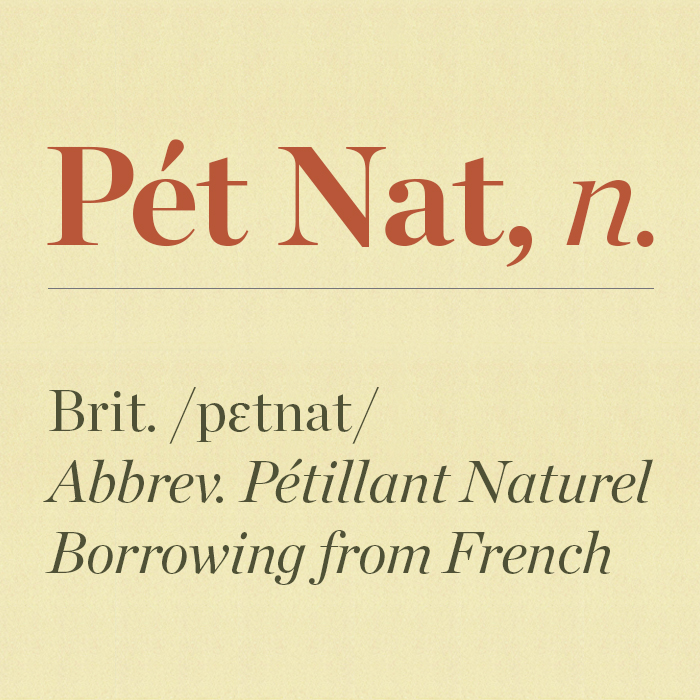Pét Nat: the trendiest fizz in town
Author: Olivia Bodle

Pétillant naturel (literally “natural sparkling”) wines are quite divisive. The snappy abbreviation of this traditional style is Pét Nat. Bottled partway through fermentation, the remaining sugar is converted by yeast into alcohol and carbon dioxide, which is trapped in the bottle and produces a gently sparkling, often cloudy, wine. While en vogue with sommeliers and hipsters now, these wines are made in the méthode ancestrale – almost certainly the oldest way of creating fizz.
First made fashionable by a new wave of producers in the Loire, you’ll now find Pét Nat popping up from Australia, California and beyond. There are no rules on grape or region; they can range from slightly sweet to almost dry, varying in colour from white to red, but shades of orangey-brown do seem to pervade. These idiosyncratic wines are poo-pooed by many; but are they actually good or just a passing fad?
It is no surprise that the hipster interest in minimal intervention and natural wines has caught onto the Pét Nat trend. Pét Nats are bottled with zero sulphur or additives, and tend to be more lightly sparkling, losing their fizz more rapidly in the glass. The lo-fi mentality of the winemaking is often echoed with a funky label. You’re most likely to see it drunk by the glass in Hackney by guys with beards and clear-framed glasses, and girls wearing chunky Fila sneakers. The phenomenon is by no means widespread; these are niche products within a niche industry, but they undoubtedly offer something new.
Refreshing and a touch more authentic than some bubbles, Pét Nat is an affordable luxury – often offering pure fruit and crisp flavours. Designed to be drunk young, they tend not to be bottled under cork, but with a crown cap. While – like any natural wine – you need to choose carefully, with an expert hand essential in producing something good; at their best, Pét Nats are the perfect summer refreshment.
The trend
2016 Birichino, Pétulant Naturel Malvasia Bianca, Monterey, California: The tongue-in-cheek name of Birichino’s Pét Nat is two fingers up to an already carefree style. This Malvasia Bianca is all about floral freshness and yeasty nectarine complexity. Perfect to enjoy on Murray Mound or in the park over the summer. Chill it standing to settle the sediment, then pour with a steady hand.
The inspiration
2015 Vouvray Pétillant, L’Ancestrale, Vincent Carême, Loire: Most trends are born of an existing style – and it’s no different with Pét Nat. This wine, made in the méthode ancestrale, is effectively a Pét Nat – but, unlike most that carry that modish name, it’s disgorged and then put under cork, leaving a clear wine. Classically Chenin Blanc, this is layered with apple, honey and minerality.



Being consumed by “guys with beards” in Hackney and girls in chunky FILA trainers is,to me, no recommendation,even if given with tongue firmly in cheek.
I would rather have a similarly priced bottle
of good Hampshire sparkling wine.
Hi, Thanks for this illuminating article.
Intrigued by the comment “touch more authentic than some bubbles”.
Please can you explain what this means? How are they ‘more authentic’ and how does this authenticity manifest?
Cheers
Phil
Dear Phil,
I can – although perhaps it is, in hindsight, a slight exaggeration. I wanted to hint at the fact that a wine made so “naturally” is seen as an “authentic” product – versus more industrially-made sparkling wine, either high-volume, lower-priced traditional-method wines, or tank-fermented sparkling, eg Prosecco (although this is not to dismiss the quality that can be found from the right producers in either category). Pét Nats tend to be made in small quantities, by more – for the lack of a better word – “artisan” producers. I hope that makes sense.
Best,
Olivia
Dear Olivia,
Thanks. I think we’re going to have to park this one for fear of boring the rest of the community to death…or take the discussion off line. I don’t get how pet nat is more natural in any way and I don’t get why small scale equals authenticity.
Over and out
…except to say I’ll give a few of these recommended wines a try.
Yet another tedious fad which sadly hasn’t yet died a death. I noticed these awful wines hitting boutique hotel bars and trendy Hackney/Hoxton/Shoreditch London restaurants about 3 years ago. They are almost universally awful.
Drivel about authenticity and phrases like “yeasty nectarine complexity” (above) simply induce face-palm weariness. Pretentious pseud-youngsters looking for a seeming short-cut way of parading wine knowledge, are latching-on with gusto. It’s horrible stuff and anyone with any taste (I mean actual tongue taste, rather than anything remotely subjective and aesthetic), knows.
[…] Palato). I even have time to hand over a gift from the outer reaches of the Empire: an English Pétillant Naturel from Tillingham Wines (which we later discover goes perfectly with […]